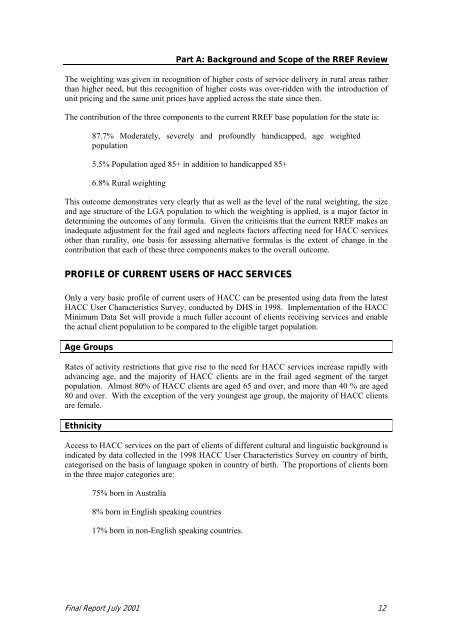Final Report on RREF 2001 - Department of Health
Final Report on RREF 2001 - Department of Health
Final Report on RREF 2001 - Department of Health
You also want an ePaper? Increase the reach of your titles
YUMPU automatically turns print PDFs into web optimized ePapers that Google loves.
Part A: Background and Scope <strong>of</strong> the <strong>RREF</strong> Review<br />
The weighting was given in recogniti<strong>on</strong> <strong>of</strong> higher costs <strong>of</strong> service delivery in rural areas rather<br />
than higher need, but this recogniti<strong>on</strong> <strong>of</strong> higher costs was over-ridden with the introducti<strong>on</strong> <strong>of</strong><br />
unit pricing and the same unit prices have applied across the state since then.<br />
The c<strong>on</strong>tributi<strong>on</strong> <strong>of</strong> the three comp<strong>on</strong>ents to the current <strong>RREF</strong> base populati<strong>on</strong> for the state is:<br />
87.7% Moderately, severely and pr<strong>of</strong>oundly handicapped, age weighted<br />
populati<strong>on</strong><br />
5.5% Populati<strong>on</strong> aged 85+ in additi<strong>on</strong> to handicapped 85+<br />
6.8% Rural weighting<br />
This outcome dem<strong>on</strong>strates very clearly that as well as the level <strong>of</strong> the rural weighting, the size<br />
and age structure <strong>of</strong> the LGA populati<strong>on</strong> to which the weighting is applied, is a major factor in<br />
determining the outcomes <strong>of</strong> any formula. Given the criticisms that the current <strong>RREF</strong> makes an<br />
inadequate adjustment for the frail aged and neglects factors affecting need for HACC services<br />
other than rurality, <strong>on</strong>e basis for assessing alternative formulas is the extent <strong>of</strong> change in the<br />
c<strong>on</strong>tributi<strong>on</strong> that each <strong>of</strong> these three comp<strong>on</strong>ents makes to the overall outcome.<br />
PROFILE OF CURRENT USERS OF HACC SERVICES<br />
Only a very basic pr<strong>of</strong>ile <strong>of</strong> current users <strong>of</strong> HACC can be presented using data from the latest<br />
HACC User Characteristics Survey, c<strong>on</strong>ducted by DHS in 1998. Implementati<strong>on</strong> <strong>of</strong> the HACC<br />
Minimum Data Set will provide a much fuller account <strong>of</strong> clients receiving services and enable<br />
the actual client populati<strong>on</strong> to be compared to the eligible target populati<strong>on</strong>.<br />
Age Groups<br />
Rates <strong>of</strong> activity restricti<strong>on</strong>s that give rise to the need for HACC services increase rapidly with<br />
advancing age, and the majority <strong>of</strong> HACC clients are in the frail aged segment <strong>of</strong> the target<br />
populati<strong>on</strong>. Almost 80% <strong>of</strong> HACC clients are aged 65 and over, and more than 40 % are aged<br />
80 and over. With the excepti<strong>on</strong> <strong>of</strong> the very youngest age group, the majority <strong>of</strong> HACC clients<br />
are female.<br />
Ethnicity<br />
Access to HACC services <strong>on</strong> the part <strong>of</strong> clients <strong>of</strong> different cultural and linguistic background is<br />
indicated by data collected in the 1998 HACC User Characteristics Survey <strong>on</strong> country <strong>of</strong> birth,<br />
categorised <strong>on</strong> the basis <strong>of</strong> language spoken in country <strong>of</strong> birth. The proporti<strong>on</strong>s <strong>of</strong> clients born<br />
in the three major categories are:<br />
75% born in Australia<br />
8% born in English speaking countries<br />
17% born in n<strong>on</strong>-English speaking countries.<br />
<str<strong>on</strong>g>Final</str<strong>on</strong>g> <str<strong>on</strong>g>Report</str<strong>on</strong>g> July <strong>2001</strong> 12
















